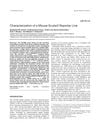SCUBE3
SCUBE3, identified through research at the University of California, Irvine, is gaining attention for its potential to revolutionize the treatment of hair loss. It is a signaling molecule produced naturally by dermal papilla cells, specialized fibroblasts located at the base of each hair follicle. These cells are crucial for hair growth, as they can signal the transition between the dormant and growth phases of the hair follicle life cycle. SCUBE3's ability to 'tell' neighboring hair stem cells to start dividing marks the onset of new hair growth, making it a key player in hair regeneration.
The genetic basis of SCUBE3 and its role in promoting hair growth, particularly in androgenetic alopecia (AGA), involves the activation of hair follicle stem cells. This process is crucial for efficient hair regeneration in both mice and humans. In cases of AA, the malfunction of dermal papilla cells reduces the production of activating molecules like SCUBE3. However, research utilizing a mouse model with hyperactivated dermal papilla cells demonstrated excessive hair growth, providing valuable insights into the regulation of hair growth and the potential of SCUBE3 as a therapeutic target.
The community's interest in SCUBE3 is marked by optimism, as discussions often revolve around its potential as a groundbreaking treatment. Members speculate about its effectiveness and the implications of ongoing clinical trials. While some express hope for SCUBE3 as a novel solution without the side effects associated with current treatments like finasteride, others await more conclusive evidence from research to validate these claims.
In summary, SCUBE3 represents a promising avenue for hair loss treatment by directly stimulating the hair follicle stem cells to induce growth. Its development and clinical trials are closely watched by both the scientific community and individuals affected by hair loss.
Research
20 / 22 results
research Expression of the SCUBE3 Epidermal Growth Factor-Related Gene During Early Embryonic Development in the Mouse

research Characterization of a Mouse Scube3 Reporter Line

research Hedgehog Signaling Reprograms Hair Follicle Niche Fibroblasts to a Hyper-Activated State

research Rhamnose-Mediated Modulation of Hair Follicle Growth: Insights from Chemical Genomics
research An Integrated Transcriptome Atlas of Embryonic Hair Follicle Progenitors, Their Niche, and the Developing Skin

research Autophagy Critically Controls Skin Inflammation and Apoptosis-Induced Stem Cell Activation

research Pu-Erh Tea Reduces the Transmission of CRD-Mediated Alopecia Risk to Offspring

research Progress on Mitochondria and Hair Follicle Development in Androgenetic Alopecia: Relationships and Therapeutic Perspectives

research Mapping Human Skin: One Sequenced Cell at a Time
research Whole-Genome Resequencing Reveals Selection Signal Related to Sheep Wool Fineness

research Self-Assembled Peptide Hydrogels in Regenerative Medicine

research Ginsenoside CK Inhibits Androgenetic Alopecia by Regulating Wnt/Beta-Catenin and P53 Signaling Pathways in AGA Mice

research Dental Cell Type Atlas Reveals Stem and Differentiated Cell Types in Mouse and Human Teeth

research The TFIID Subunit TAF4 Regulates Keratinocyte Proliferation and Has Cell-Autonomous and Non-Cell-Autonomous Tumor Suppressor Activity in Mouse Epidermis

research Transcriptomic Analysis of Human Skin Wound Healing and Rejuvenation Following Ablative Fractional Laser Treatment

research Human Fetal Scalp Dermal Papilla Enriched Genes and the Role of R-Spondin-1 in the Restoration of Hair Neogenesis in Adult Mouse Cells

research Lineage Commitment of Dermal Fibroblast Progenitors Is Mediated by Chromatin De-repression

research Trajectory of Human Induced Pluripotent Stem Cells Derived Neural Progenitor Cells Differentiation into Dermal Papilla-Like Cells and Their Characteristics

research Stabilization of Epithelial Beta-Catenin Compromises Mammary Cell Fate Acquisition and Branching Morphogenesis
